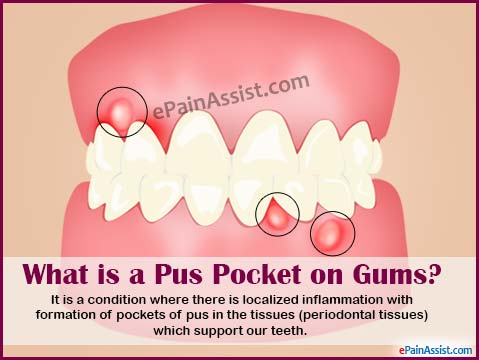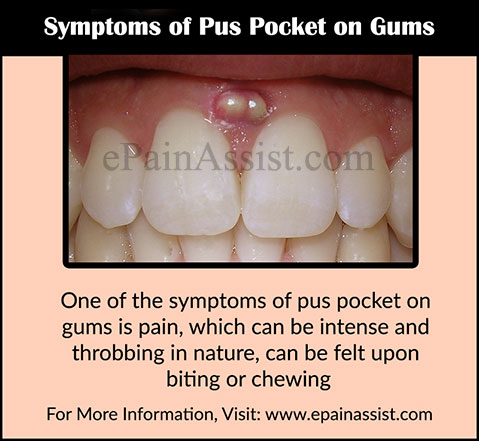What is a Pus Pocket on Gums?
Pus pocket on the gums, commonly known as gum abscess and medically known as periodontal abscess, is a condition where there is localized inflammation with formation of pockets of pus in the tissues (periodontal tissues) which support our teeth. Pus pocket on the gums causes soreness, redness and pain in the gums and in the tooth involved. The tooth can also feel loose and there can be pain felt upon biting or chewing. Pus can also be seen oozing from the pus pockets in the gums.

Causes & Risk Factors for Pus Pocket on Gums
Pus pockets on gums or gum abscess occurs due to invasion and multiplication of bacteria within the gum pockets. This can occur due to any of the following factors:
- Any injury to the gums from foreign body, such as fishbone, toothbrush bristle or toothpick can lead to formation of pus pockets on gums.
- Any obstruction in the opening to a gum pocket.
- Incomplete removal of tartar and plaque from under the gum line from deep gum pockets.
- Pus pockets can also form as a result of pulp disease through lateral root canals or the root tip.
- Conditions, such as bruxism which exert undue pressure on biting can cause infection and pus pockets on the gums.
- Not brushing properly leaves the food stuck in between the teeth which leads to build up of bacteria, which in turn leads to infection and pus pockets on the gums.
- Changes or decrease in the immune response, such as seen in medical conditions like diabetes.
- Perforation of the lateral sides of the tooth walls during procedures, such as root canal treatment can cause pus pockets on gums.
Signs & Symptoms of Pus Pocket on Gums

- One of the symptoms of pus pocket on gums is pain, which can be intense and throbbing in nature, can be felt upon biting or chewing.
- The affected tooth can become loose or appears elevated in the socket.
- The affected gum appears swollen, red and is painful to touch.
- There is formation of pus with tracking through the bone resulting in a shiny, red, painful swelling on the jaw bone.
- There could be symptoms of oozing or discharge of pus through the gum pocket.
- The pus can spread into the soft tissues causing facial cellulitis.
- There is increased temperature with enlargement of the lymph nodes around the affected region.
- If the pus pockets on the gums are left untreated, then there can be sepsis of the digestive tract or liver problems.
Difference between Gum Abscess & Tooth Abscess
The symptoms of a gum abscess resemble the symptoms produced by a tooth abscess. However, it is important to differentiate between both the conditions as the treatment required is different for both. The following factors help in differentiating between gum abscess and tooth abscess:
- The location of the pus pocket or the abscess helps in determining whether it is a gum abscess or a tooth abscess. If the pus pocket or abscess is present at the root tip, then it indicates a pulp origin, which is seen in dental abscess.
- If there is decaying in the tooth with sensitivity to cold or hot, then it indicates tooth abscess.
- If there is gum disease with bone loss and pocketing then it indicates a gum abscess.
- In case of a dead tooth, it can be either a gum or a tooth abscess.
- If the tooth is normal and healthy, but there are pus pockets present on the gum with inflammation of the gum, then it is a gum abscess.
Diagnosis of Pus Pocket on Gums
- X-rays are taken for identify the source of infection, whether it originates from the tooth or the gums.
- The vitality of the tooth is tested by doing a pulp vitality test.
- Microbial test is done by taking a sample of the pus for culture and sensitivity for identifying the bacteria involved.
- Blood sugar test can also be done.
How to Get Rid of Pus Pocket on Gums?
Treatment for Pus Pocket on Gums
Treatment for pus pocket on gums comprises of relieving the pain and controlling or preventing the infection from spreading elsewhere. Drainage is done through the gum pocket or by making an incision on the abscess in the mouth.
Ways to Get Rid of Pus Pocket on Gums
Drainage of pus pockets on the gums through incision
- A horizontal incision is made using a surgical blade on the region of the swelling, which appears the most fluctuant.
- A periodontal elevator or curette is then used to lightly lift up the tissues to allow drainage of the pus.
- After the pus drainage stops, the affected gum region is irrigated using saline water.
- In this method, sutures are usually not needed.
- Patient is then told to rinse his/her mouth a few times.
- Antibiotics can be prescribed along with pain killers for pain relief.
- The patient is told to follow up the next day.
Drainage of pus pockets on the gums through the gum pocket:
- The affected region is anesthetized using local or topical anesthesia.
- A probe is gently inserted into the gum pocket to distend the wall of the pus pocket to allow drainage.
- The pus eases out of the pocket.
- Saline irrigation is done of the affected region.
- A curette is then gently introduced into the pocket to allow further pus drainage and to curette any granulation tissue if present.
Follow Up Treatment for Pus Pocket on Gums
- Scaling and root planning under the gum line, i.e. subgingival is done.
- Periodontal flap surgery is done for treating any bone defects, as the pus pockets on the gums can penetrate the jaw bone.
- Tooth extraction may be needed if the involved tooth is in a bad condition.
- Antibiotics are prescribed if the infection has spread and the patient has symptoms, such as facial swelling, fever, inflammation of the adjacent lymph nodes.
Home Remedies to Get Rid of Pus Pocket on Gums
- Lemon is rich in vitamin C and helps in strengthening the teeth and preventing gum inflammation. Using lemon juice on the affected region helps in getting rid of the pus pockets on gums.
- Unripe guava is also rich in vitamin C and contains a styptic agent. Chewing on raw guava helps in halting the formation of pus in the gums. Rinsing with mouthwash, made of juice of guava tree bark, helps in arresting the gum bleeding and pus discharge from the gums. Chewing guava leaves also helps in getting rid of the pus pockets on the gum.
- Onion contains potent bactericidal agents, which help in preventing gum bleeding. Chewing on raw onion helps in killing germs and in getting rid of pus pockets on the gums.
- Juice made up of carrot and raw spinach in equal quantities is very beneficial in treating the pus pockets on the gums and bleeding of gums.
- Lettuce leaves chewed before meals helps in preventing and curing pus pockets on the gums.
- Orange is also rich in vitamin C, which helps in keeping gums and teeth healthy. The orange peel can be rubbed on the gums to prevent pus pockets on the gums.
- Pepper powder used along with salt makes a very good dentifrice for dental problems, such as plaque, caries, sensitive teeth, bleeding gums and pus pockets on the gums.
- Powdered rind of the pomegranate mixed with pepper and common salt helps in fighting bacterial infection by getting rid of plaque and tartar from the teeth and gums.
- Soaking wheat soaked in water for about 10 minutes and then chewing it is a good exercise for increasing blood circulation towards teeth and gums and is beneficial in treating pus and bleeding from gums.
- Application of marjoram oil extract on the gums about two times a day helps in getting rid of the pus pockets on the gums.
- Application of mixture comprising of holy basil leaves, which are dried and powdered and mixed with mustard oil, on the tooth and gums helps in treating pus pockets in the gums, toothache and gum bleeding.
- Chewing fresh bark of babul tree helps in stopping bleeding and getting rid of pus from the gums.
Prevention of Pus Pockets on Gums
Pus pockets on the gums or any other dental problems mostly occur as a complication of gum disease or tooth decay. Any type of dental problems can be prevented with practicing good oral hygiene. Some of the measures for preventing pus pockets on the gums include:
- Maintaining good oral hygiene by brushing teeth twice a day and flossing daily.
- Using mouthwashes help in preventing bacteria buildup, thus preventing pus pockets on the gums.
- For healthy teeth and gums, it is important to follow a healthy diet and avoid sugary foods and drinks. Consuming foods, which are rich in vitamin C, such as grapes, lime, oranges, guava and pineapple help in teeth and gum health.
- Quitting smoking helps in improving oral hygiene.
- Toothpick use should be avoided as much as possible and dental floss should be used instead.
- It is important to have yearly dental check-ups to identify and prevent gum and teeth problems.
Prognosis of Pus Pocket on Gums
The prognosis of pus pocket on gums or gum abscess is good, if treated on time. The pus can be easily drained and the involved tooth can also be saved if it is not badly affected. If the pus pockets on the gums are left untreated, then the abscess can burst into the mouth or on to the skin of the face, which can in turn leave a sinus tract between the stubborn source of infection and the mouth/skin. This leads to regular discharge of the pus, which can lead to other complications, some of which although uncommon, can be quite fatal and include: Sinusitis, osteomyelitis, cavernous sinus thrombosis and dental cyst. So it is important to seek immediate medical attention at the first sign of symptoms, such as severe pain, fever, difficulty in opening the mouth, breathing or swallowing; swelling on the face, jaw and on the base of the mouth.
Complications tend to develop in individuals who have diabetes and who have compromised immune system, such as individuals with HIV/AIDS, chemotherapy, taking steroids, sickle cell anemia and removal of spleen.
Also Read:
